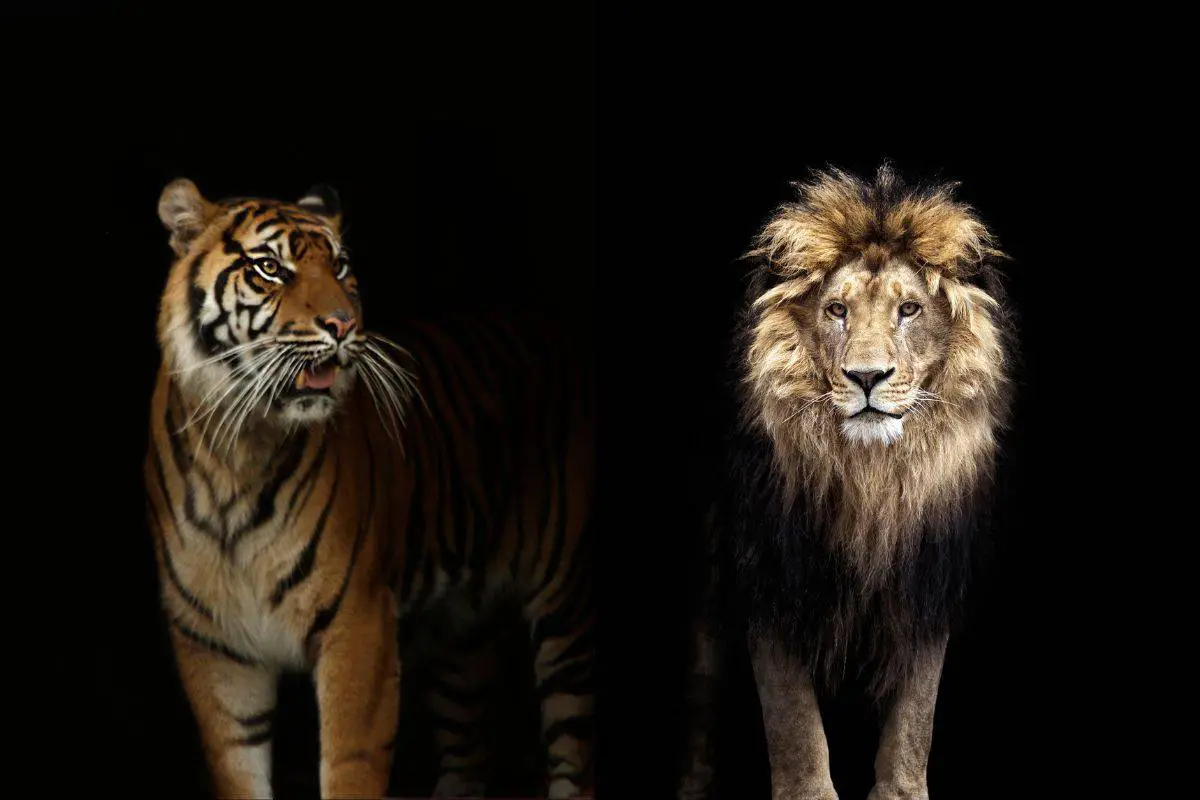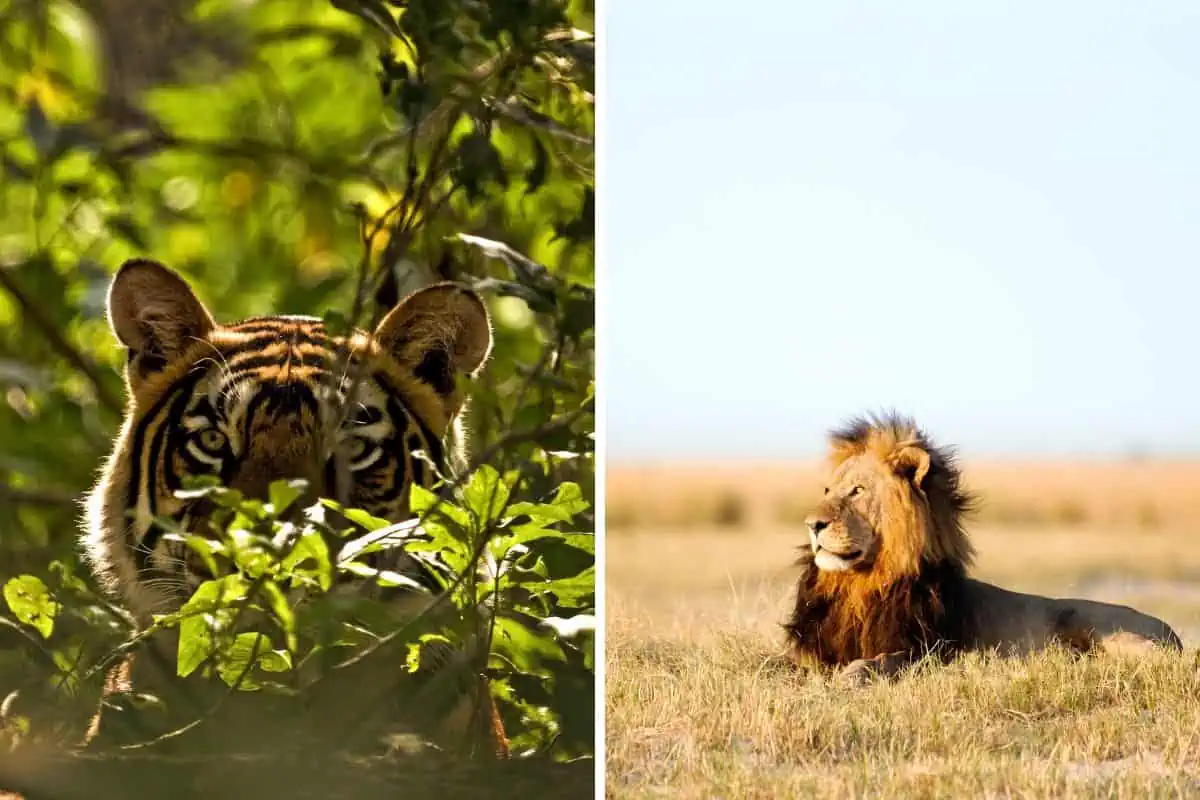Discover the fascinating world of big cats as we delve into a detailed comparison between lions and tigers, two apex predators that reign supreme in their habitats.
Explore their unique characteristics, behaviors, and ecological roles while understanding the importance of their conservation.
10 differences between lions and tigers:

Lion vs Tiger Overview
| Feature | Lion | Tiger |
|---|---|---|
| Physical Traits | Tawny, Mane | Stripes |
| Size | Up to 400 lbs | Up to 600 lbs |
| Distribution | Africa, Asia | Asia |
| Prey Preference | Large Ungulates | Medium to Large Prey |
| Hunting Style | Pack Hunting | Ambush |
| Agility | Less Agile | Highly Agile |
| Bite Force | 650 PSI | 1050 PSI |
| Aggression Level | Curious | Avoids Humans |
| Social Behavior | Pride Living | Solitary |
| Conservation | Vulnerable | Endangered |
1. Physical Appearance
With its tawny fur and faint spots, the lion is easily recognizable. Males of the species sport a mane, giving them a regal appearance.
Tigers are known for their unique stripe patterns, which vary for each animal. They usually have orange-colored fur, but color variations give rise to white, golden (strawberry), and black tigers.
The lion and the tiger belong to the Felidae family and are part of the Panthera genus. These majestic animals exhibit distinct physical differences that make it easy to tell them apart.
2. Size Comparison
Male lions can reach up to 10 feet in length from snout to tail tip and weigh up to 400 lbs. Female lions are slightly smaller, reaching around 9 feet in length.
Conversely, Tigers can easily reach 13 feet from snout to tail tip, with the largest individuals weighing over 600 lbs. Female tigers are considerably smaller.
The sexual dimorphism in both lions and tigers is evident in the size differences between males and females.
While the lion’s mane might give the impression of a larger animal, the tiger is the undisputed heavyweight champion among the big cats.
3. Geographic Distribution

Lions are predominantly found in Africa, roaming the continent’s vast plains. The Asiatic lion, however, resides in a specific region within the Gir National Park in Gujarat, India.
Tigers mainly inhabit Asia, with different subspecies spread across various countries. No wild tigers are living in Africa. In places like the Tiger Canyon in South Africa, however, they can be seen in as close to a wild environment as you’ll find.
Understanding the distribution of these magnificent creatures is essential for wildlife conservation efforts, as it helps identify the specific ecosystems that need to be preserved to ensure their survival.
Protecting these apex predators’ habitats contributes to the ecosystem’s overall balance and supports animal biodiversity.
4. Prey Preference
Lions prefer hunting larger ungulates weighing up to 550 kg, such as wildebeest, zebra, buffalo, and giraffe. Their preference for bigger prey helps feed their entire pride, which consists of multiple lions.
Tigers, being opportunistic hunters, typically target medium to large prey like deer and wild boars, weighing up to 250 kg. However, they will also consume smaller mammals and birds if necessary.
The predator-prey relationships of these big cats play a crucial role in maintaining the balance within their respective ecosystems.
As top predators, they help regulate the populations of their prey species, ensuring that ungulate numbers do not grow out of control.
5. Hunting Techniques
Lions are social hunters that work best in a coordinated group or pride. They rely on teamwork to run down their prey to the point of exhaustion, increasing their chances of a successful hunt.
Tigers are ambush predators, relying on stealth and superior strength to sneak up on their prey. They often utilize the cover of darkness and dense foliage to remain hidden until the perfect moment to strike.
The distinct hunting techniques of lions and tigers demonstrate their natural adaptations to their habitats and showcase their specialized predatory behavior.
6. Agility
While lions possess powerful forelimbs, their hind legs are comparatively weaker, making them less agile than tigers. Lions use their strength primarily to hold onto their prey during a hunt.
Tigers are incredibly agile, with their muscular build and powerful hindquarters contributing to their impressive jumping and climbing abilities.
They can cover significant distances vertically and horizontally in a single leap.
The agility of these big cats is a testament to their evolutionary adaptations and is a key factor in their success as apex predators in their respective environments.
7. Bite Force
Lions have a bite force of 650 PSI, which, while strong, is not the most powerful among the big cats.
Tigers possess a significantly stronger bite force of 1050 PSI, almost twice as powerful as that of a lion. This makes them one of the most formidable predators in the animal kingdom.
The difference in bite force between lions and tigers highlights their specialized hunting techniques and the prey they target.
Understanding these characteristics contributes to our knowledge of animal behavior and their role within the ecosystems they inhabit.

8. Aggression Level
Lions are naturally curious about humans, often watching them from a distance. They generally only display aggression if their territory is invaded or if they feel threatened.
Tigers are more likely to avoid human contact and can be aggressive when threatened or cornered.
Although both species can be dangerous to humans, it is important to remember that these animals simply defend themselves, their young, or their territory.
Encounters with wild lions or tigers can be fatal, so respecting their space and avoiding interactions whenever possible is crucial.
9. Social Behavior
Lions are the most social representatives of the big cat family, living in prides consisting of 2 to 3 males, 8 to 12 females, and a few lion cubs. There is a hierarchy within the pride that prioritizes males, females, and the lion cubs.
Tigers, in contrast, prefer a solitary life and only come together with other tigers for mating purposes.
However, they have occasionally been observed sharing meals with other tigers under specific circumstances, such as when they are related, raised together, or when food is abundant.
These big cats’ social behavior affects their hunting techniques and plays a role in their mating and overall survival strategies.
10. Conservation Status
Lions are currently classified as “vulnerable” on the IUCN Red List. While their situation is not as dire as that of tigers, they still require conservation efforts to protect their populations and habitats.
Tigers are listed as “endangered,” facing significant threats from habitat loss, poaching, and human-wildlife conflict. Their conservation is critical to ensure the species’ survival for future generations.
Both lions and tigers require concerted efforts from wildlife conservation organizations, governments, and individuals to ensure their continued existence in the wild.

